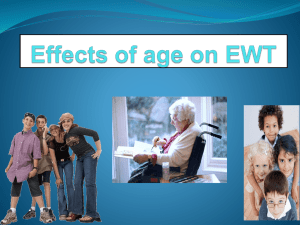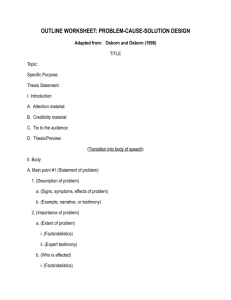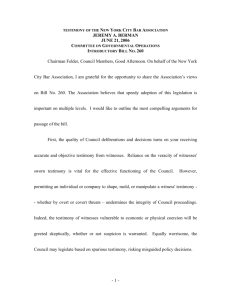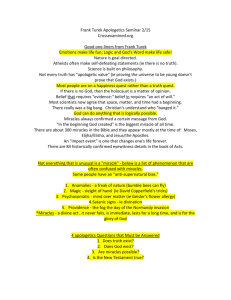Fullwood, Judd & Finn - Video Mediation
advertisement
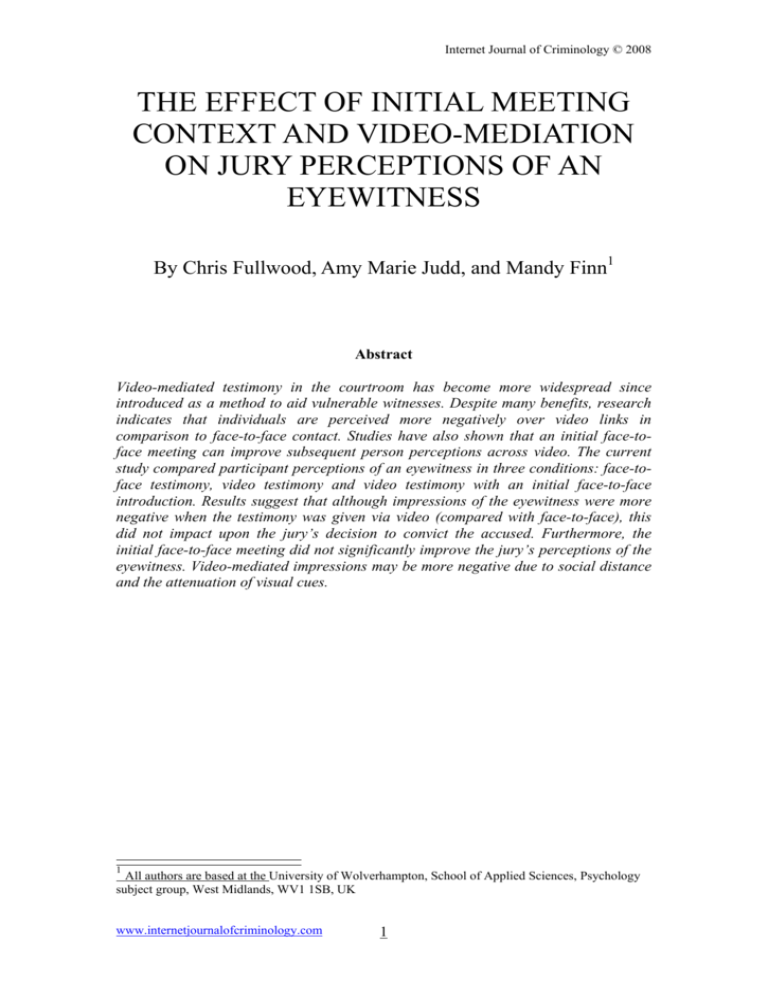
Internet Journal of Criminology © 2008 THE EFFECT OF INITIAL MEETING CONTEXT AND VIDEO-MEDIATION ON JURY PERCEPTIONS OF AN EYEWITNESS By Chris Fullwood, Amy Marie Judd, and Mandy Finn1 Abstract Video-mediated testimony in the courtroom has become more widespread since introduced as a method to aid vulnerable witnesses. Despite many benefits, research indicates that individuals are perceived more negatively over video links in comparison to face-to-face contact. Studies have also shown that an initial face-toface meeting can improve subsequent person perceptions across video. The current study compared participant perceptions of an eyewitness in three conditions: face-toface testimony, video testimony and video testimony with an initial face-to-face introduction. Results suggest that although impressions of the eyewitness were more negative when the testimony was given via video (compared with face-to-face), this did not impact upon the jury s decision to convict the accused. Furthermore, the initial face-to-face meeting did not significantly improve the jury s perceptions of the eyewitness. Video-mediated impressions may be more negative due to social distance and the attenuation of visual cues. 1 All authors are based at the University of Wolverhampton, School of Applied Sciences, Psychology subject group, West Midlands, WV1 1SB, UK www.internetjournalofcriminology.com 1 Internet Journal of Criminology © 2008 1. Introduction Presenting evidence in open court can be a daunting prospect, especially for vulnerable individuals such as child witnesses. The courtroom can be an intimidating environment particularly as witnesses are frequently forced to confront the accused. In sexual assault cases the victim is often required to talk in detail about the assault, undoubtedly a stressful and embarrassing experience (Taylor and Joudo, 2005). Clearly there are compassionate grounds for distancing the witness from the courtroom. Extreme states of emotional arousal are also known to impair our ability to perform cognitive tasks successfully (see Yerkes-Dodson, 1908). As it is imperative that a witness gives an accurate and detailed account of an event, it would seem necessary to limit the amount of stress and emotional trauma experienced in the courtroom. Addressing this issue, the Criminal Justice Act (1988) pronounced that evidence could be given via a live video link rather than in open court, meaning that children would not be put under unnecessary duress. Further legislation proposed under Part Two of the Youth Justice and Criminal evidence Act (2002) now means that all vulnerable witnesses (including adults) are eligible for video link testimony. Furthermore, the use of a live video link is now compulsory for sexual assault cases involving children. Of particular interest to the current study is the manner in which presenting evidence in this fashion impacts upon person perceptions and jury decision-making. It would seem that video-mediated technologies were introduced into the courtroom in order to protect vulnerable and intimidated witnesses and a number of studies do indeed suggest that this practice has been successful in fulfilling this aim. Davies and Noon (1991) for example interviewed child witnesses in the U.K in order to assess their attitudes towards the use of live video links. It was noted that children who presented evidence over a video link tended to be less unhappy than those giving evidence in open court. Furthermore, the witnesses were more audible and forthcoming with their testimony. Doherty-Sneddon and McAuley (2000) concluded that video links helped to reduce emotional and social pressure in children therefore making the process of presenting evidence easier. Although these findings are clearly interesting, it should be noted that they cannot be generalised to adult witnesses. More recently a Home Office survey indicated that witnesses of all ages found videomediated technologies to be helpful when presenting evidence. Furthermore, 98per cent of witnesses who had presented evidence over a video link indicated that they had the opportunity to say everything that they wanted to, compared to only 43per cent who presented their evidence in open court (Hamlyn et al., 2004). Although these studies recognise the potential shortcomings of using video-mediated communication in court (for example, the attenuation of visual cues), on the whole they note the significant advantages of using the technology. For example, it is clear that many witnesses would not give evidence if the only option was to present it in open court. While there is sufficient evidence to imply that video links make the process of giving evidence easier for vulnerable witnesses, Orcutt et al. (2001) argue that jury members reach decisions more effectively and witnesses are more likely to be honest if face-toface confrontation takes place. In the courtroom, an increased significance is placed on our ability to detect whether another individual is telling the truth. The jury s decision will not only be influenced by the evidence presented to them, but will also hinge on the impressions that they form of the witness. Furthermore, physically www.internetjournalofcriminology.com 2 Internet Journal of Criminology © 2008 removing someone from the courtroom places social distance between themselves and the jury members. Evidence from Fullwood (2007) would suggest that social distance may have a bearing upon impression-formation. In Fullwood s study, it was found that participants who communicated across a video link were regarded as less likeable and less intelligent when compared with participants who communicated face-to-face. Although there are a number of possible explanations for this finding, it would seem likely that we hold less favourable attitudes about those we feel distanced from. Horn (2001) also noted that participants found it more difficult to detect deception and other subtle nonverbal cues when someone was presented to them via a video link. However, experimental findings also indicate no differences in perceptions of credibility between video-mediated and face-to-face conditions (Orcutt, 1995; Goodman et al., 1998). Although there is some evidence to put forward the notion that video-mediated communication may impact negatively upon impression formation, there is no reason to necessarily believe that such perceptions would affect the decision-making process of the jury. Indeed, a number of studies have shown that face-to-face and video-mediated testimonies do not differ in terms jury perceptions of guiltiness (see Taylor and Joudo, 2005). However, what they do imply is that our perceptions of others can be influenced by statement context. It is common with the use of live video links to portray a partial view of the witness, especially with children who might sit lower down in the camera shot (Burton et al, 2007). This can make it more difficult to visualise body language, which may be an important nonverbal signal that jury members look for when evaluating witnesses (Burton et al, 2007). In a face-to-face setting, a number of researchers have noted the importance of nonverbal cues in detecting deception. According to McNeill (1985) gestures are closely linked with speech in so far as they share the same psychological structure. He argued that gestures are part of the psychology of speaking and are not fundamentally different from speech itself (pg. 351). This close link would intimate that our bodily actions are actually direct manifestations of our thought processes. As the body is seen as a leakier channel (in other words we have less conscious control over it), when there is incongruence between what is spoken and what is communicated with the body, it is argued that this is a strong indicator of dishonesty (Argyle, 1988; Kleck and Nuessle, 1968). It would however seem imprudent to consider incongruence as a formula for detecting dishonesty. Hocking (1977) for example indicates that bodily responses normally associated with lying are as likely to be caused by a stressful event as they are by someone faking a false statement. Although the attenuation of visual signals might be perceived as a disadvantage when it comes to detecting the truth, De-Paulo and Pfeifer (1986) found that even trained experts in related fields such as customs officers were no more accurate than student participants at distinguishing the truth from a lie. This seems to imply that the detection of deception is a difficult task generally. Further evidence that questions the use of video links in the courtroom comes from the Scottish Office (1995). The report noted that lawyers were particularly critical of the technology, chiefly because it placed restrictions on how easily they could build a rapport with the witness. The video link also made if difficult for lawyers to cross examine the witness, lessened the impact of the evidence, and detracted from the jury s capability to gather an accurate reflection of the witness s demeanour. Evidence from this report verifies that video-mediated communication disrupts our ability to form accurate impressions, as well as presenting a barrier to successful www.internetjournalofcriminology.com 3 Internet Journal of Criminology © 2008 communication. Although video-mediated testimonies seem to put the witness at a disadvantage, Eastwood and Patton (2002) noted that many defence lawyers made positive evaluations of the use of a video link in the courtroom. The use of such technologies would place distance between the witness and the jury, however the defendant would still be present in the courtroom. It would seem then that the negative evaluations of the witness caused by using the technology benefit the defendant. According to Doherty-Sneddon et al. (1997) and Boyle et al. (1994) video-mediated interactions are less efficient when compared with face-to-face interactions, a consequence of the technology placing restrictions on our ability to communicate successfully. There is more to communication than the words we speak; we also rely on a number of audio signals (for example, intonation, pitch, tone) in order to express meaning in a message. We also impart messages through our bodily activity (for example gesture, facial expressions, posture) and children in particular are heavily reliant of these signals as they are not always as competent as adults when it comes to articulating ideas into words (Church and Goldin-Meadow, 1986; Doherty-Sneddon and Kent, 1996). A number of researchers have argued that, in comparison to face-toface contexts, visual signals are often diluted over video, and therefore have a weakened impact (Heath and Luff, 1991; Rutter, 1987). Hence, it could be argued that those who would rely on such cues in order to get a message across effectively would be unable to do so successfully over a video link. According to Heath et al. (1995), video-mediated messages are less effective because the video monitor distorts the visual image; therefore the bodily activity expressed at one end of the video link will be very different from what the person sees at the other end of it. A number of studies suggest that video-mediated communication can influence person perceptions negatively, and although this has yet been found to influence jury decision-making, it is nonetheless an interesting phenomenon. One possible method that be may be employed to rectify this problem would involve introducing the witness to the jury before the video-mediated evidence is given. This would place minimal pressure on the witness as he/she would not be required to present evidence, but would simply be physically present for a short period of time in order to bridge the intimacy distance caused by the video-mediated barrier. This practice has been used in other video-mediated contexts with promising results. Derrer et al. (2006) for example investigated the effect of initial meeting context on subsequent videomediated interviews. In one condition an initial meeting took place between the interviewer and the interviewee face-to-face, and in the other condition the meeting took place over video. After the meeting had taken place all participants witnessed the interview via video and formed part of an interview panel, for which they were required to rate aspects of the interviewee s performance and character. It was found that the interviewee was rated significantly more favourably in terms of friendliness, job suitability, honesty, and employability in the face-to-face meeting condition. This study suggests that person perceptions can be improved if an initial face-to-face meeting takes place before video-mediated exposure. Rocco s (1998) research also indicates that an initial face-to-face meeting can improve perceptions of trust between co-workers in a computer-mediated collaborative context. The present study will compare participant reactions to three types of testimony: face-to-face testimony, video-mediated testimony and video-mediated testimony with an initial face-to-face introduction. It is expected that participant perceptions will be more favourable in the www.internetjournalofcriminology.com 4 Internet Journal of Criminology © 2008 face-to-face and video-mediated with face-to-face introduction conditions and least favourable in the video-mediated condition. 2. Method 2.1 Participants The sample comprised 60 participants taken from a large U.K University. There were 53 females, and 7 males having a mean age of 21.20 years and an age range of 18-31. Participants were recruited via the use of a sign-up sheet. The participants assigned themselves to one of three conditions on the basis of the time slot they signed up for. Twenty participants took part in condition 1 (face-to-face testimony); 20 participants were in condition 2 (video-mediated testimony) and 20 participants took part in condition 3 (video-mediated testimony with initial face to face introduction). The confederate, a female actor of 21 years of age, played the role of the eyewitness and was obtained externally from the University in order to minimise the chance that participants would be familiar with her. 2.2 Materials A statement concerning a fictitious account of a domestic incident witnessed by the confederate was designed for the study. The confederate was given the statement 3 weeks before the study took place in order that she could recall the statement sufficiently from memory. A Panasonic VHS Movie Camera NV-M50 with stand and blank VHS videotape were used to record the eyewitness reciting the statement (for use in conditions 2 and 3). The recording took place during condition 1 so that all testimonies would be identical except for the manner in which they were presented. A medium shot camera angle was employed, the scope of which was the head and upper body. The eyewitness was recorded looking in the direction of the camera (but not into it). The video camera was placed out of view of the participants so that it would not distract them and so that a clear image of the eyewitness could be recorded. A Panasonic NV-HS900 VHS Video Cassette Recorder and a Philips LC4246 Data/video projector were used to present the testimonies to the participants on a Bretford series 750 Electronic Projection Screen in conditions 2 and 3. A questionnaire was designed to assess participant evaluations of the testimony. This included the following statements, which were rated using a 7-point Likert scale (ranging from 1 strongly disagree to 7 strongly agree ). 1) The eyewitness appeared sincere when giving the statement (credibility) 2) I could emotionally engage with the eyewitness (emotional engagement) 3) I would convict the accused based on the evidence given by the eyewitness (likelihood of conviction) 2.3 Procedure Participants allocated themselves to one of three conditions on the basis of the time slot they signed up for: condition 1 (face to face testimony), condition 2 (videomediated testimony) and condition 3 (video-mediated testimony with initial face to face introduction). All 20 participants in each condition took part in the task simultaneously. All participants were sat facing the front of the room, so that they could have a clear view of the eyewitness in condition 1, and the data projector in conditions 2 and 3. Condition 1 ran first, so that a recording of the testimony could be taken and subsequently used in conditions 2 and 3. In condition 1, participants were www.internetjournalofcriminology.com 5 Internet Journal of Criminology © 2008 first introduced to the eyewitness by the experimenter. This involved the eyewitness standing at the front of the room in full view of the participants while the experimenter introduced her by name and explained that she had been witness to a domestic incident. To set the context further, participants were given standardised instructions, which outlined their role in the task as well as informing them that the testimony was based on a factual event. Once this had been done, participants watched the eyewitness present her account face-to-face and then completed the questionnaire. In condition 2, participants were introduced to the eyewitness across the video link and again were given the standardised instructions. Following on from this, participants watched the pre-recorded testimony (which they were led to believe was being presented real time over a video link) and then completed the questionnaire. In condition 3, participants were introduced to the eyewitness face-toface, and were then given standardised instructions after she had left the room. To ensure maximum realism, the eyewitness wore the same clothes during the face-toface introduction as in the video recording. Following on from this, participants watched the pre-recorded testimony (which they were led to believe was being presented real time over a video link) and then completed the questionnaire. Participants in all three conditions were debriefed as to the nature of the deceptions after completion of the study. 3. Results Participants indicated their responses to the three questions using a 7-point Likert scale. Mean scores were calculated for each question separately for the three conditions: condition 1 (face to face testimony), condition 2 (video-mediated testimony) and condition 3 (video-mediated testimony with initial face to face introduction). Mean scores and standard deviations are provided in Table 1. Table 1: Mean scores (with standard deviations in parentheses) assessing credibility, likelihood of conviction and emotional engagement for the three presentation conditions. Question 1) The eyewitness appeared sincere when giving the statement 2) ) I could emotionally engage with the eyewitness Condition Condition 1 (face to face) Condition 2 (video) Condition 3 (video with f-t-f intro) Condition 1 (face to face) Condition 2 (video) Condition 3 (video with f-t-f intro) 3) I would convict the accused Condition 1 (face to face) based on the evidence given by Condition 2 (video) the eyewitness Condition 3 (video with f-t-f intro) Mean (s.d) 5.75 (1.02) 4.80 (1.51) 5.15 (1.04) 5.05 (1.28) 3.60 (1.43) 4.20 (1.48) 4.20 (1.58) 3.40 (1.50) 4.25 (1.65) To examine the effect of the three presentation conditions, three one-way betweensubjects ANOVA s were conducted. Results indicated an overall significant effect for the question the eyewitness appeared sincere when giving the statement (F (2, 57) =3.151; p<0.05) and an overall significant effect for the question I could emotionally engage with the eyewitness (F (2, 57) =5.454; p<0.05). However, for question 3 ( I would convict the accused based on the evidence given by the eyewitness ) no significant effect was found. www.internetjournalofcriminology.com 6 Internet Journal of Criminology © 2008 Post hoc follow-up tests were employed (Tukey s HSD) for questions 1 and 2. It was found that there were significant differences between condition 1 (face-to-face testimony) and condition 2 (video-mediated testimony) (p<0.05) for both questions. No significant differences were found with any other comparisons. 4. Discussion Results indicate that real jury perceptions may well be influenced by mode of presentation. Specifically, the proxy jury member subjects in this experiment perceived themselves to be less able to emotionally engage with the witness and felt that the testimony was less believable when presented via video compared to the faceto-face presentation. These findings are supported by previous literature, for example Davies and Noon (1991) noted that jury members tend to be less empathetic towards video-mediated witnesses. It is possible that emotional engagement is affected by social distancing. Argyle and Dean (1965) assert that human beings like to maintain a comfortable intimacy distance with others, and a number of cues are used to express intimacy, for example eye contact and proximity. The use of a video link would render the expression of many intimacy cues impossible (specifically proximity), making it more difficult to adequately form a desired level of intimacy with another individual. Moreover, nonverbal cues can be used to express emotion (Argyle, 1988), and with their attenuation it would be more difficult to express emotions effectively. The fact that the video-mediated testimony also influenced jury perceptions of credibility may be partly explained by the manner in which video communication disrupts the normal modulations of eye gaze. Gazing behaviour has been noted to play an important role in detecting deception (Hemsley and Doob, 1978; Kraut and Poe, 1980); therefore any disruption to this process might effect how easy it is to determine whether someone is telling the truth. Further investigation might therefore test the impact of varying levels of simulated eye contact across video (for example by using gaze correction software see Gemmel and Zhu, 2002). It may also be the case that social distancing caused by the video link resulted in more negative perceptions of the witness generally. Indeed, Fullwood (2007) has shown video-mediated communication to result in negative evaluations of intelligence and likeability. The findings also revealed no differences between the conditions in the likelihood of convicting the accused based on the witness testimony. This supports previous research findings (e.g. Taylor and Joudo, 2005) and suggests that although impression formation may be affected by statement context this does not necessarily affect the decision-making process of the jury (at least in this instance). One might only speculate as to the impact that the varying severity of crimes would have on jury decision-making when comparing face-to-face and video-mediated testimonies. However, whereas the testimony in this study related to a fairly innocuous incident, Taylor and Joudo (2005) showed that mode of testimony (live link, pre-recorded image, live face-to-face) had little effect on the jury s perceptions of whether the accused was guilty and the credibility of the complainant when testimonies were taken from an authentic transcript from a sexual assault case. This however, does not take into consideration the possibility that participants in that study knew they were taking part in an experimental study and therefore their decision-making would have no consequences for a real defendant. www.internetjournalofcriminology.com 7 Internet Journal of Criminology © 2008 The analysis of the results has also shown that the initial introduction prior to the video-mediated testimony did little to improve jury perceptions of the witness. Specifically, no significant differences were discovered between the video condition with initial face-to-face introduction and the video condition without an initial faceto-face introduction. It can therefore be concluded that an initial face-to-face introduction would not necessarily improve juror s perceptions of a witness in a video-link trial. Although Derrer et al. (2006) have shown that initial face-to-face meetings improve subsequent perceptions of individuals across a video link, the results of this study do not support this. The fact that there were no significant differences in jury perceptions of the witness between the face-to-face condition and the video condition with initial face-to-face introduction is however promising. This possibly suggests that the initial exposure time to the witness may not have been sufficient to bridge the intimacy distance. Therefore, further investigation may wish to investigate the effects of varying levels of initial introduction time on subsequent impression formation. Although the findings from this research are theoretically interesting, there are number of weaknesses which need to be considered. Firstly, as the eyewitnesses in the study was an adult, it would not be possible to generalise these findings to situations in which child witnesses would be used. The study was also contrived in nature, and although the participants were led to believe that the testimony was about a real life incident, it would have still been clear to them that any decisions they made would not have had any ramifications for a defendant. Although there are clear weaknesses, overall, results indicate that perceptions of the witness are likely to be more negative when the testimony is presented via a video link. Findings from this investigation and previous research suggest that the implementation of video technologies in the courtroom is likely to put the witness at a disadvantage. Indeed, there is evidence here to show that the witness is seen as less sincere and the jury feel less able to emotionally engage with the witness. Although a number of technological solutions might go some way to resolve these issues (for example, gaze correction software), it seems likely that the attenuation of visual cues and the creation of social distance caused by video links negatively impact upon person perceptions. Clearly there are benefits associated with distancing vulnerable witnesses from the courtroom. Because there is a potentiality for person perceptions to be influenced negatively by videomediated communication, the findings from this research would suggest that this should be taken into consideration when using this technology in the courtroom. Acknowledgments Special thanks go to Ian Jukes for his technical expertise. www.internetjournalofcriminology.com 8 Internet Journal of Criminology © 2008 References Argyle, M. (1988) Bodily Communication (second edition). London: Routledge. Argyle, M., and Dean , J. (1965) Eye contact, distance, and affiliation, Sociometry, 28: 289-304. Boyle, E.A., Anderson, A.H., and Newlands, A. (1994) The effects of visibility on dialogue and performance in a co-operative problem solving task, Language and Speech, 37(1): 1-20. Burton, M., Evans, R., and Sanders, A. (2007) Vulnerable and intimidated witnesses and the adversarial process in England and Wales, The International Journal of Evidence and Proof, 11(1): 1-16. Church, R.B., and Goldin-Meadow, S. (1986) The mismatch between gesture and speech as an index of transitional knowledge, Cognition, 23: 47-71. Davies, G. and Noon, E. (1991) An evaluation of the live link for child witnesses. Home Office report. De-Paulo, B., and Pfeifer, R. (1986) On the job experience at detecting deception, Journal of Applied Social Psychology, 16: 249-267. Derrer, N.M., Fullwood, C., Davis, S.J., Martino, O.I. and Morris, N. (2006) An initial face-to-face meeting improves person-perceptions of interviewees across VMC, in Bust, P.D. (ed) Contemporary Ergonomics 2006. London: Taylor and Francis. Doherty-Sneddon, G., and Kent, G. (1996). Visual signals and the communication abilities of children, Journal of Child Psychology and Psychiatry, 37: 947-959. Doherty-Sneddon, G., Anderson, A.H., O Malley, C., Langton, S., Garrod, S., and Bruce, V. (1997) Face-to-face and video-mediated communication: A comparison of dialogue structure and task performance, Journal of Experimental Psychology, 3(2): 105-125. Doherty-Sneddon, G., and McCauley, S. (2000) Influence of video-mediation on adult-child interviews: Implications for the use of the live link with child witnesses, Applied Cognitive Psychology, 14: 379-392. Eastwood, C.J., and Patton, W. (2002) The experiences of child complainants of sexual of sexual abuse in the criminal justice system, Criminology Research Council Grant report. Fullwood, C. (2007) The effect of mediation on impression formation: A comparison of face-to-face and video-mediated conditions, Applied Ergonomics, 38(3): 267-273. www.internetjournalofcriminology.com 9 Internet Journal of Criminology © 2008 Gemmel, J., and Zhu, D. (2002) Implementing gaze-corrected videoconferencing, Communications, Internet and Information Technology (CIIT), November, 18-20: 382-387. Goodman, G.S., Toby, A.E., Batterman-Faunce, J.M., Orcutt, H., Thomas, S., Shapiro, C. and Sashsenmaier, T. (1998) Face to face confrontation: Effects of closed circuit technology on children s eyewitness testimony and juror s decision, Law and Human Behaviour, 22: 165-203. Hamlyn, B., Phelps, A., Turtle, J., and Sattar, G. (2004) Are special measures working? Evidence from the surveys of vulnerable and intimidated witnesses. Home Office Research Study, No. 244, London: the Home Office. Heath, C., and Luff, P. (1991) Disembodied conduct: Communication through video in a multimedia environment, Proceedings of CHI 91 Human Factors in Computing Systems (pp 99-103), New York: ACM. Heath, C., Luff, P. and Sellen, A. (1995) From video-mediated communication to technologies for collaboration: re-configuring media space in Emmott, S.J. (ed). Information Superhighways: Multimedia Users and Futures, London: Academic Press. Hemsley, G.D., and Doob, A.N. (1978) The effect of looking behavior on perceptions of a communicator s credibility, Journal of Applied Social Psychology, 8: 136-144. Hocking, J.E. (1977) Detecting deceptive communication from verbal, visual and paralinguistic cues: An exploratory experiment, Dissertation Abstracts International, 37(9-B): 4756. Horn, D.B. (2001) Is seeing believing? Detecting deception in technology mediated communication, Proceedings of CHI 2001, Short papers, New York: ACM Press. Kleck, R., and Nuessle, W. (1968) Congruence between the indicative and communicative functions of eye contact in interpersonal relations, British Journal of Social and Clinical Psychology, 7: 241-246. Kraut, R.E., and Poe, D. (1980) Behavioral roots of person perception: The deception judgements of customs inspectors and laymen, Journal of Personality and Social Psychology, 39: 784-798. McNeill, D. (1985) So you think gestures are nonverbal? Psychological Review, 92(3): 350-371. Orcutt, H. (1995) Detecting deception: Fact finders abilities to assess the truth, Doctoral Dissertation State University of New York at Buffalo, NY. Orcutt, H.K., Goodman, G.S., Tobey, A.E., Batterman-Faunce, J.M., and Thomas, S. (2002) Detecting deception in children s testimony: Fact finders abilities to reach www.internetjournalofcriminology.com 10 Internet Journal of Criminology © 2008 the truth in open court and closed circuit trials, Law and Human Behavior, 25(4): 339-372. Rocco, E. (1998) Trust breaks down in electronic contexts but can be repaired by some initial face to face contacts, Proceedings of CHI 1998, 496-502. Rutter, D. (1987) Communicating by Telephone. Pergamon. Scottish Law Commission. Sections 56-60 of the Law Reform (Miscellaneous Provisions) (Scotland) Act 1990. The Scottish Office: Central Research Unit. Crime and Criminal Justice Research Findings No. 4., 1995. Live television link: An evaluation of its use by child witnesses in Scottish criminal trials. The Scottish Office. Section 32 of the Criminal Justice Act 1988. Taylor, N. and Joudo, J. (2005) The impact of pre-recorded video and closed circuit television testimony by adult sexual assault complainants on jury decision-making: an experimental study, Research and Public Policy Series, Australian Institute of Criminology. Yerkes, R.M, and Dodson, J.D. (1908) The relation of strength of stimulus to rapidity of habit-formation, Journal of Comparative Neurology and Psychology, 18: 459-482. Youth Justice and Criminal Evidence Act., 2002. Chapter 1 part II. www.internetjournalofcriminology.com 11


